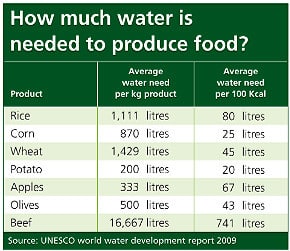Potatoes play an important role in feeding the world as they are one of the largest food crops on the planet. The world is increasingly facing land and water issues, so potatoes are an excellent food choice. They are an efficient plant as 85% of what grows can be eaten – however, the leaves and fruit are not eaten. Other crops, like rice, wheat and maize are less efficient with only about 50% of the plant being eaten.
Potatoes need a lot less water to grow than other carbohydrates. It is very difficult to come up with accurate water-use figures; the large variety of food-growing and production techniques used worldwide means that the amount of water needed can vary a huge amount depending on how and where the food is grown. In New Zealand, the amount of water used to grow 1 kg potatoes is less than needed internationally. Yields can vary considerably depending on management, however, on average, in New Zealand it takes 105 litres of water to produce 1 kg potatoes. Source: Plant and Food Research, Lincoln, 2013.
The UNESCO World Water Development Report 2009 shows that potatoes use much less water than other carbohydrates. See Table below.

All the potatoes New Zealanders eat are grown in New Zealand which means there is less impact on the planet as they do not have to be transported from overseas.
Potatoes grow in a wide range of conditions and produce more food, more quickly, on less land and in harsher climates, using less water than any other major food crop. As the world’s population is expected to grow on average by more than 100 million people a year, the challenge is to ensure food security while protecting natural resources. More than 95% of that increase will occur in developing countries, where the pressure on land and water is already intense. Potatoes are seen as part of the solution to world food security.
Studies considering the carbon footprint of potatoes show potatoes produce less greenhouse gas than most other foods – one study in Scientific American (February 2009) shows weight for weight potatoes generate 57 times less greenhouse gases than beef and 13 times less than chicken. More study is being undertaken in this area.


